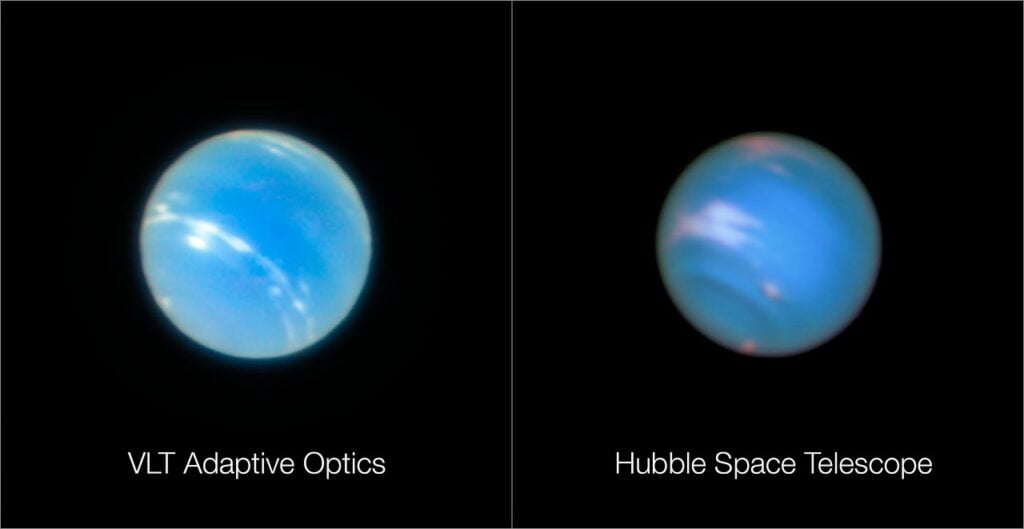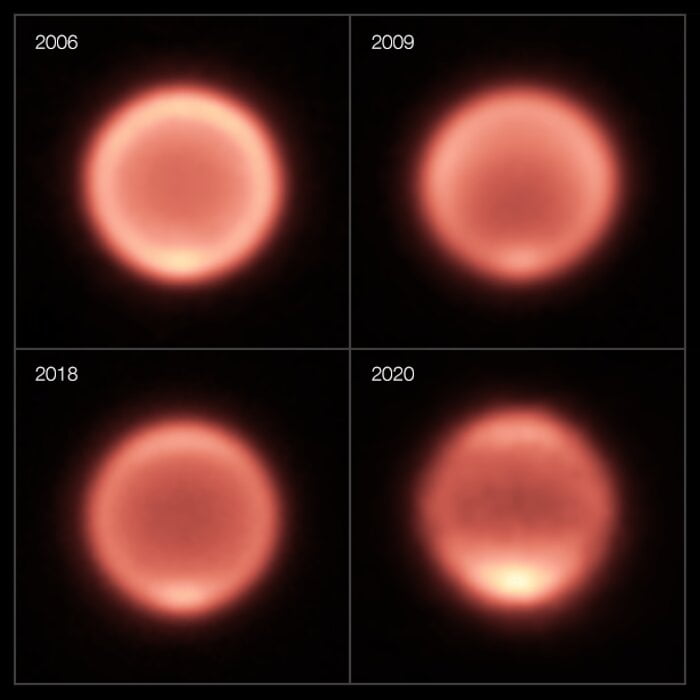Global temperatures at Neptune unexpectedly cooled over the past 20 years

Researchers using ground-based telescopes to track Neptune’s atmospheric temperatures over a 17-year period found a surprising drop in the planet’s global temperatures followed by dramatic warming at its south pole.
The lead author of the study published this week in The Planetary Science Journal, Michael Roman, said the change they discovered was unexpected. Roman is a postdoctoral research associate at the University of Leicester, UK.
“Since we have been observing Neptune during its early southern summer, we expected temperatures to be slowly growing warmer, not colder,” Roman added.
A season at Neptune lasts around 40 years, with one Neptune year lasting 165 Earth years. It has been summertime in Neptune’s southern hemisphere since 2005, and the astronomers were eager to see how temperatures were changing following the southern summer solstice.
Study authors looked at nearly 100 thermal-infrared images of Neptune, captured over a 17-year period, to piece together overall trends in the planet’s temperature in greater detail than ever before.
These data showed that, despite the onset of southern summer, most of the planet had gradually cooled over the last two decades. The globally averaged temperature of Neptune dropped by 8 °C (14 °C) between 2003 and 2018.
The astronomers were then surprised to discover dramatic warming of Neptune’s south pole during the last two years of their observations when temperatures rapidly rose for 11 °C (19.8 °F) between 2018 and 2020. Although Neptune’s warm polar vortex has been known for many years, such rapid polar warming has never been previously observed on the planet.

“Our data cover less than half of a Neptune season, so no one was expecting to see large and rapid changes,” said co-author Glenn Orton, a senior research scientist at Caltech’s Jet Propulsion Laboratory (JPL) in the US.

Because Neptune is roughly 4.5 billion km (2.9 billion miles) away and is very cold (average temperature reaches around –220 °C / -364 °F) so measuring its temperature from Earth is no easy task.
“This type of study is only possible with sensitive infrared images from large telescopes like the Very Large Telescope (VLT) that can observe Neptune clearly, and these have only been available for the past 20 years or so,” said co-author Leigh Fletcher, a professor at the University of Leicester.
Because Neptune’s temperature variations were so unexpected, the astronomers do not know yet what could have caused them.
They could be due to changes in Neptune’s stratospheric chemistry, or random weather patterns, or even the solar cycle.

More observations will be needed over the coming years to explore the reasons for these fluctuations.
Future ground-based telescopes like ESO’s Extremely Large Telescope (ELT) could observe temperature changes like these in greater detail, while the NASA/ESA/CSA James Webb Space Telescope will provide unprecedented new maps of the chemistry and temperature in Neptune’s atmosphere.
Reference:
Sub-Seasonal Variation in Neptune’s Mid-Infrared Emission from Ground Based Imaging – Roman et al. – The Planetary Science Journal – 2022 – arXiv:2112.00033v2
Featured image credit: ESO/P. Weilbacher (AIP)/NASA, ESA, and M.H. Wong and J. Tollefson (UC Berkeley)

“More observations will be needed over the coming years to explore the reasons for these fluctuations.”????
It’s a NORMAL CYCLE. Just as the Earth goes through it’s NATURAL, NORMAL CYCLES. THE UNIVERSE……also goes through NATURAL, NORMAL CYCLES. (CAUSED by THE SUN!!!!!!)
Just as Edgar Cayce said that, in the time period that WE ARE LIVING IN NOW (on Earth), we would goes through MASSIVE EARTH CHANGES; an EXTINCTION LEVEL EVENT……that IS a NATURAL, NORMAL CYCLE. This HAS HAPPENED…..MANY TIMES BEFORE. There is NO ‘global warming’/’climate change’, as what the Psycho Globalists want people to FALSELY BELIEVE (’caused by humans’)!!! We are heading into an Ice Age. With MUCH MORE…..UNTHINKABLE ‘MORE’, to go along with that! To FURTHER REINFORCE what Edgar Cayce said WILL HAPPEN, in THIS TIME PERIOD, go to youtube and watch Suspicious0bservers for ACTUAL Science. IGNORE REAL SCIENCE……and you PERISH! YOUR CHOICE! We are heading into our (Earth’s) 12,000 AND 6,000 Year Cycle…..IGNORANCE is a CHOICE!